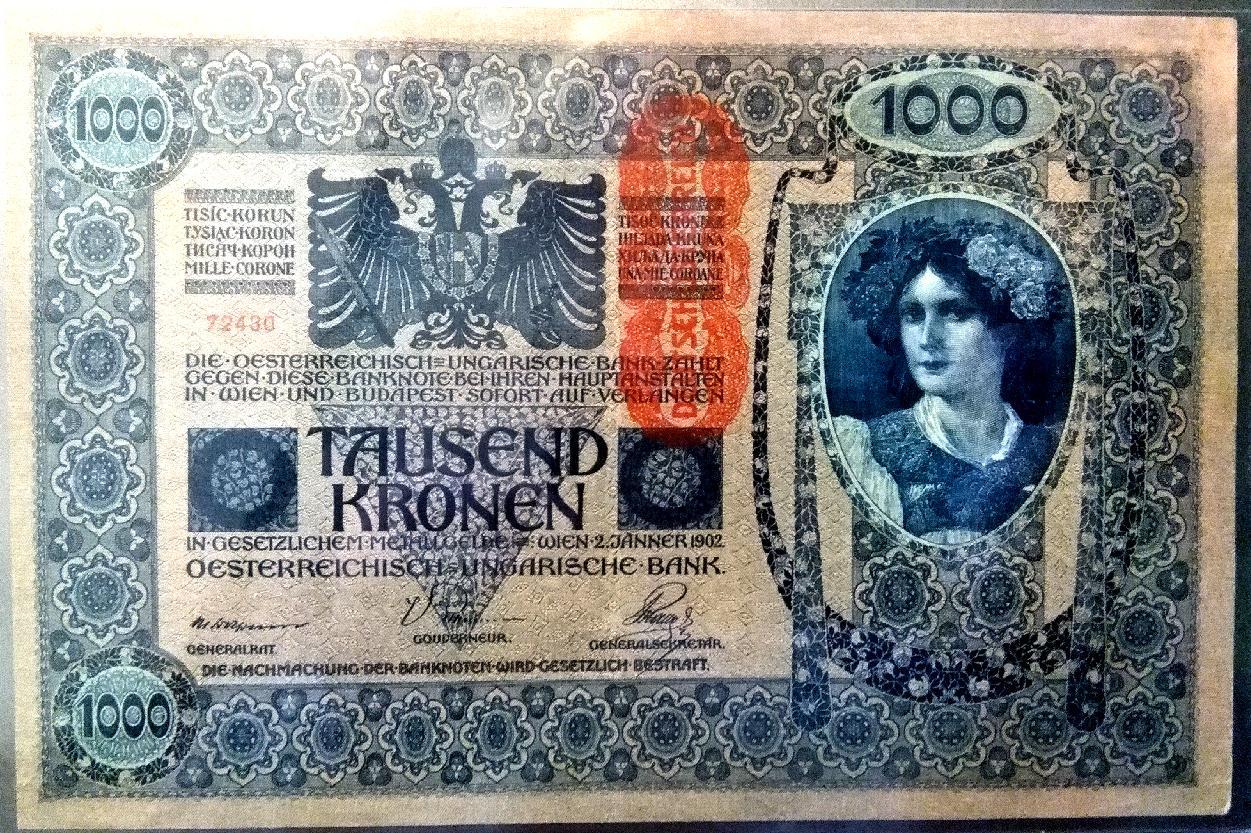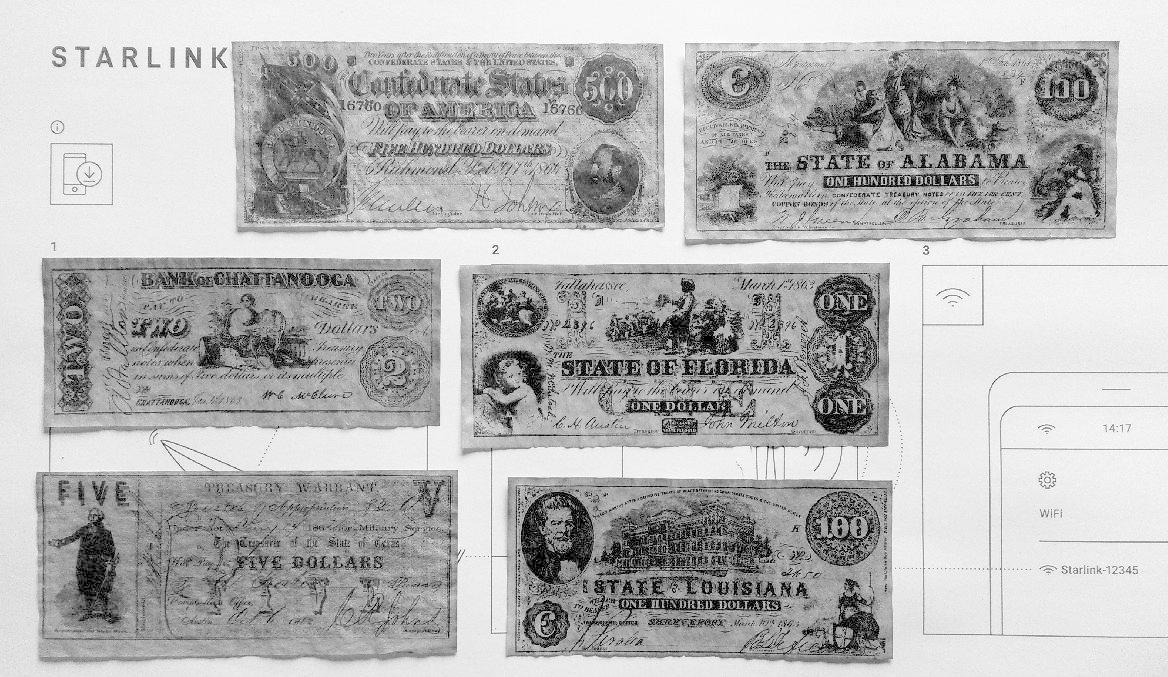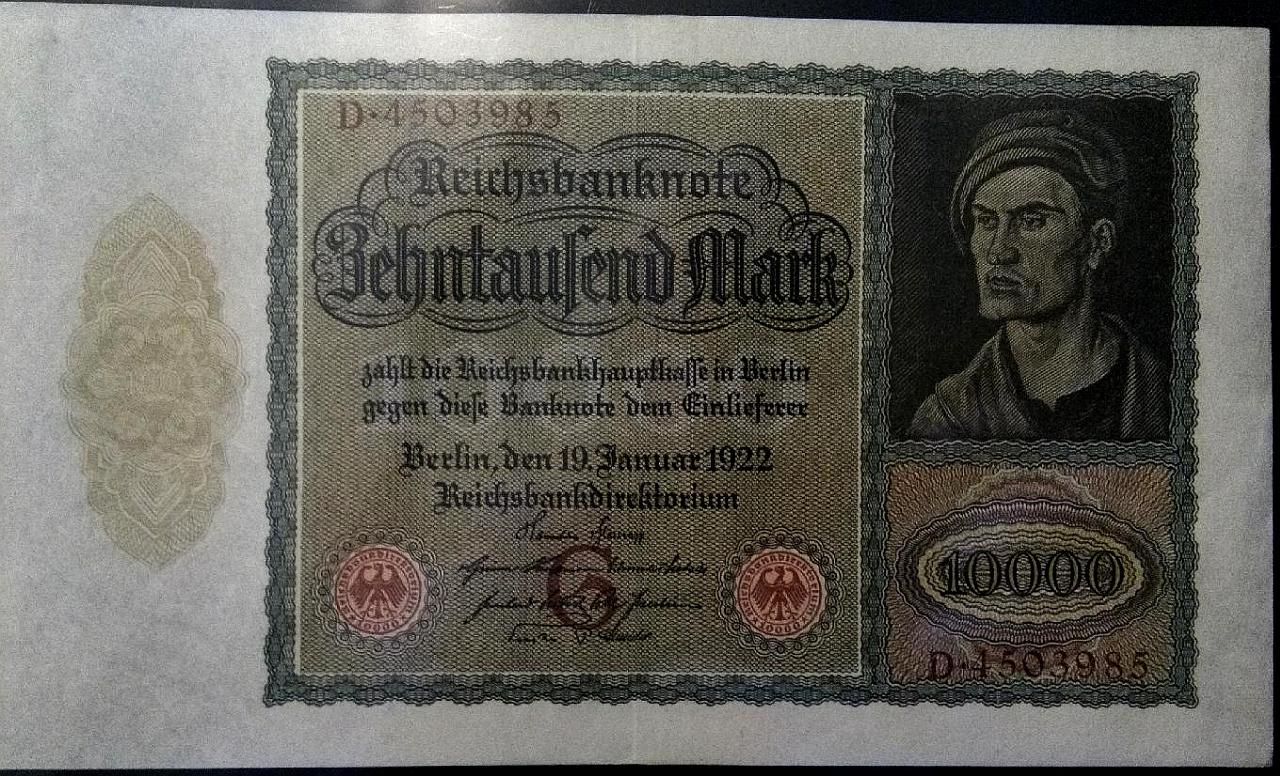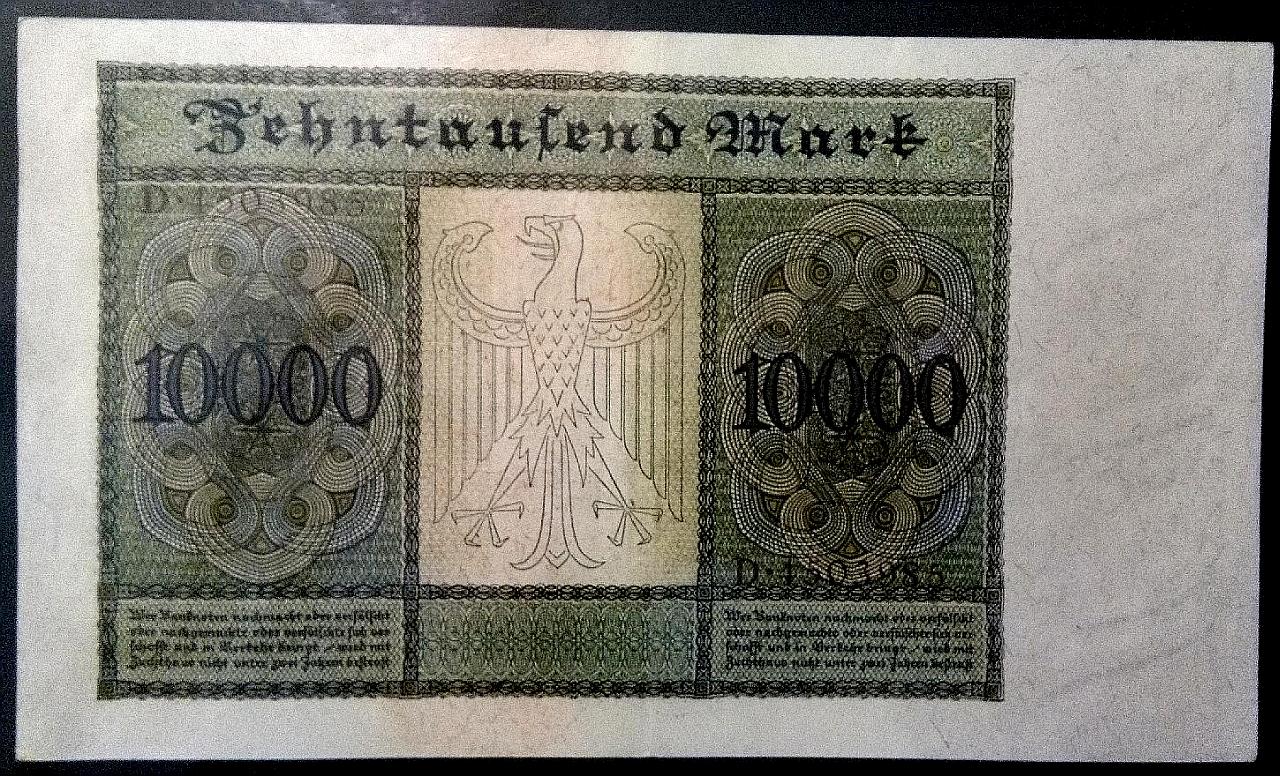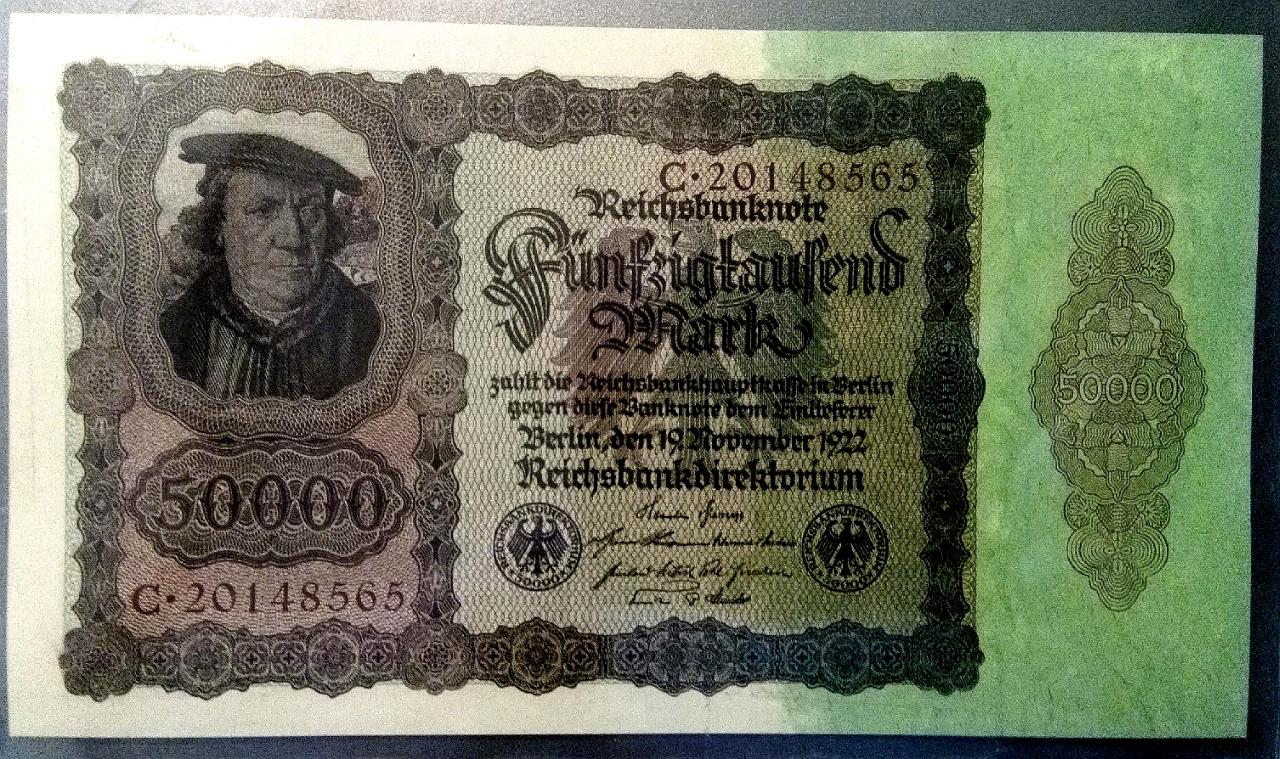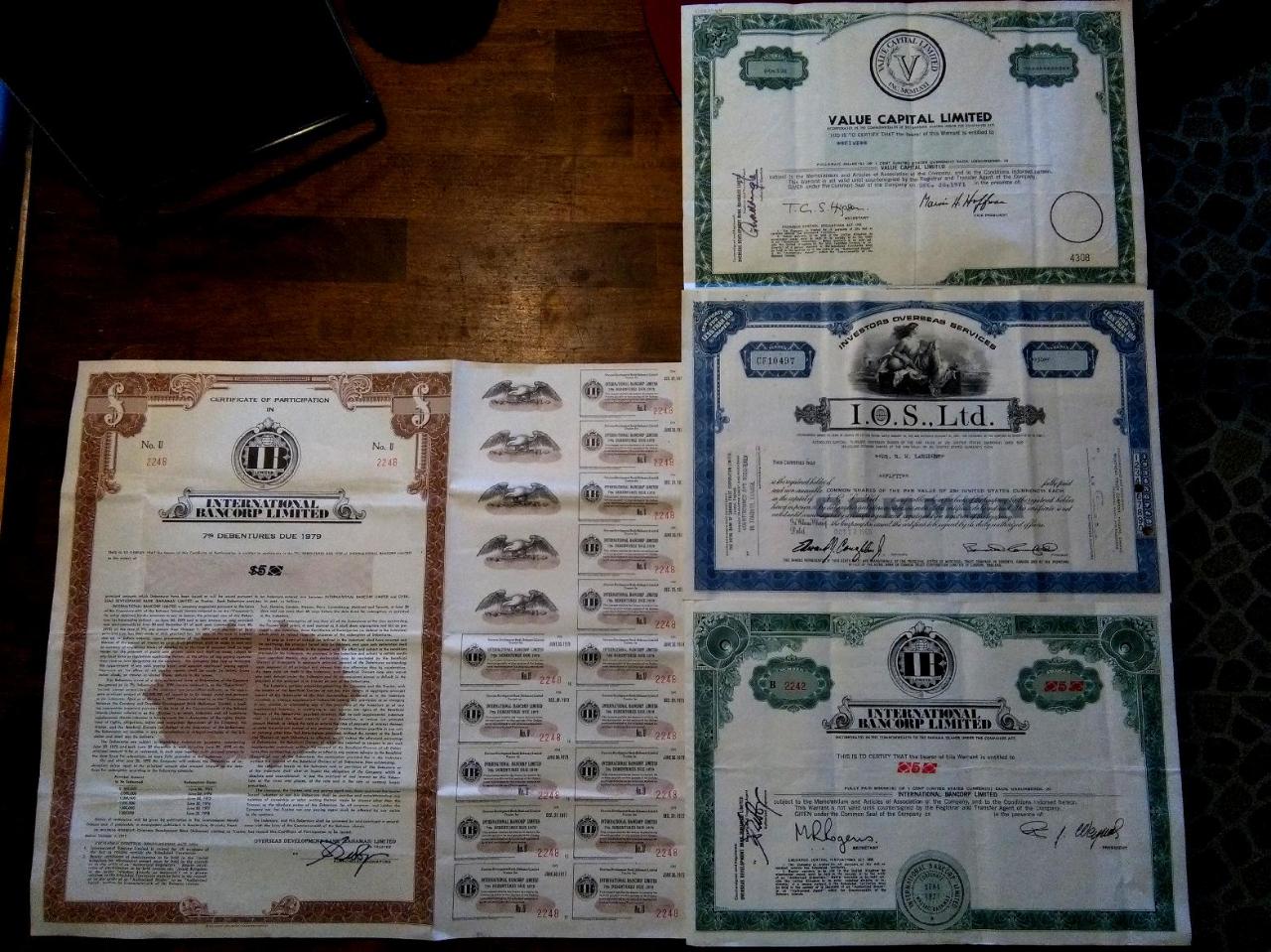American government-printed "money" that is completely worthless. These are government and bank issued banknotes circulated by the various Confederate States of America, back in the 1860's. (No connection with Starlink. Starlink satellite internet works great - I just needed a white piece of cardboard to arrange the notes upon.)
We all need to recognize, just how truly "virtual" paper-money really is. All it takes to create the stuff is a printing press - and with a computer, and a "central bank" - and a banking system of some sort - you don't even need the printing presses. People like Neel Kashkari should be careful when he says crypto-currency is "95% scam." That might be true - but government-issued paper-money is also about as bogus as anything has ever been, in all of history. History proves this beyond any doubt whatsoever - even for the special Americans.
There is an interesting truth in analysis work: If something happens once, it can happen again. It won't be exactly the same event - but the fact that it happened once means that the probability of a such an event occuring again, is far above zero. You might want to have a plan for what you will do, if and when worst-case scenarios manifest themselves. "When in Danger, or in Doubt, Shout and Yell, And Dash About!" - is not really the best strategy.
You may have a box full of "money" - but that material called "money", is only as valuable as the integrity of the State that issued it. Most nation-state bank-notes eventually become worthless - or only valuable as antique, historical artifacts.
German 100 Mark bank-note. This was real money at the time, roughly 1908. It would have had purchasing power somewhere around what a 100 dollar bill from USA had - probably a bit more. It was a respectable amount of cash. It is dated: Berlin, February 7th, 1908. This was three years after Einstein published his famous 1905 paper on the photoelectric effect, possibly because of Max Planck's recommendation. The Swiss patent-examiner got his work published in the respected Physics journal, Annalen der Physik. This bank note comes from Europe's centre of learning and science. After the First World War ended, it rapidly became virtually worthless.
This is a 10,000 Mark bank-note, from the German Reichsbank, from Berlin, 19th of January, 1922. When it was first printed, it was serious money. The image is a portrait of a young man, by Albrecht Durer. With a couple of years, the note was virtually worthless, due to the runaway hyper-inflation of the German Weimer Republic.
Another beautiful quality 50,000 Mark Reichsbanknote, from Berlin, originally made in 19 November, 1922. This beautiful, multi-coloured bank-note rapidly became worthless, as the bank-note demoninations ran up into the millions, as the German hyper-inflation was engineered and implemented by the deeply unwise people at the German Central Bank at the time. The First World War reparations had to be paid in *gold*, so there was no advantage to Germany to inflate its domestic currency, to reduce the require war-cost payments. The German Central Bank simply had a bad economic model, which suggested that a certain "British-pound value" of currency had to be kept in circulation, to keep the economy operating. So, as the exchange-rate with the British Pound deteriorated, the reactive-response from the German Central Bank, was to print ever larger amounts of currency. This pro-cyclic strategy substantially accelerated the devaluation of the currency, but it did effectively to maintain full employment.
The Central Bank in Germany, at the time, took great pride in its ability to fabricate and distribute ever greater physical quantities of cash. There seemed to be no understanding - until the entire place fell into a rather curious abyss of economic collapse, which induced France to invade the Ruhr Valley (Industrial heartland) of Germany in January of 1923. By the fall of 1923, a dozen eggs which cost 1/2 a Mark, in 1918, cost 4 billion Reichmarks by October of 1923. This inflation rendered this 50,000 Mark note from November, 1922, essentially worthless. But for a while, it had been real money.
What is truly hilarious, is that I paid $20.00 (Canadian) for this bank note, in May of 2021, as a historial artifact, given that it is in basically mint condition. It is in a collage of other bank notes, in a frame, on the wall in my office. It hangs near the worthless stock certificates and debentures, which I found among my father's legacy: (Common shares in "I.O.S - Investors Overseas Service" and shares and debentures of "International BankCorp Limited" and "Value Capital Limited" - also completely worthless, except as historial artifacts which give evidence to the routine fragility of financial schemes.)
You can hold cash, shares, and/or bonds and debentures. Holdings of each of these asset classes carries risk - and sometimes, that risk is very substantial. You think you possess wealth - but after some time has passed, you only possess a historical artifact. And in these modern times, you might not even have that! :)
And here, we have a collection of beautifully printed, on fine paper, some common share certificates and debentures (complete with little clipable "coupons"!), which are of course, completely worthless - at least as far as their original financial valuation is concerned. But as physical artifacts from the end of the Great 1960's Stock Market Boom, they are, I feel, most interesting and valuable, and I am going to frame these as a collection, also.
They date from 1970-71 period, and as family we were doing very well. The oil-shock was still two years away, and I recall in the Autumn of 1971, my father bought a 1972 Pontiac LeMans for my mother. It later became my car, and I truly loved that machine. It had a big, orange-block V8, and I personally bolted a rear "anti-sway" bar between to two rear cantilever arms of the suspension. This modification massively improved the handling of the vehicle, allowing it to be drifted around corners - at velocity. I found that to be a very nice feature.
Would that we could engineer similar stability in the financial markets! As I have written this, I've watched GOOG, GME and FVRR all move up sharply, as my bank stock holdings have drifted down from their positive opening prices of the early AM. Curious world.
Please, if you are investing now - I beg you to be careful. The Amerian "Democrats" have proposed a $2.5 trillion US dollar economy-wide tax increase, to pay for the massive new "free-money-for-poor-people" schemes they are also attempting to create. This is possibly the largest tax increase in American history, in dollar terms.
At some point, the stock market is going to notice that this is all probably going to happen.
You really want to be positioned so you can accept a 50% drop in the value of your investment holdings, and not have it destroy your life. As of Sept. 13th, our models still have a slight upward bias, but it seems to be fading a bit, each day so far this month.
Here is an image of "money" that is *NOT* worthless. Not by a long shot. But it's NOT money! This is One Dollar of famous "Canadian Tire 'Money'", which were these bank-note-like store-coupons, issued for *many* years by Canadian Tire franchise stores in Canada, and redeemable for merchandise sold in Canadian Tire stores - like auto-parts, tires, sporting-goods, (including guns and ammunition!), and even gasoline, if you had early-issue coupons like this. These "coupons" were even printed by the "British-American Bank Note Company", and they incorporate modern security features found in traditional government-issued bank-notes. They are serial-numbered on the back, they have extreme micro-printing above where it says "La Societe Canadian Tire Limitee" and below where it says "Canadian Tire Corporation, Limited", and they have special paper, which incorporates watermarks (the Canadian Maple Leaf above the word "only" in the white central triangle).
What is amusing, is that here in 2021, they can still be redeemed for merchandise at the Canadian Tire franchise stores, and have - to an impressive extent - retained most of their purchasing power. They have performed *VASTLY* better than virtually all African currency, almost all Central and South American currency, and most European currency (and *ALL* Communist and former "Eastern Block" currency notes.) These 'money' coupons are now serious collector's items, and generally are not often redeemed in the Stores anymore, as the "Laughing Scotsman" is such a Canadian icon, that people hang on to the notes for nostagia value. The Canadian Tire stores now issue only digital coupon-money, which can be accumulated and spent, using a debit-style digital card or key-fob bar-code.
I quite like the old "Laughing Scotsman", since I am partly Scottish, am seriously frugal, and also enjoy this early pre-internet economic "money-meme" image. I like to imagine what kind of image a New York chain store might have used - perhaps a great, fat Jew, with a huge nose, looking like a German cartoon from the 1930's? Of course, in this modern politically correct world, this would be impossible.
But you can watch brilliant (and I mean *really very clever and funny*) anime cartoons, made by the genius artist, Max Fleischer, to get an idea. He made "Betty Boop's Ups and Downs", and had a sequence where the planets get together, and the Moon auctions off the Earth, in a "fire-sale", of falling bid-prices. The final (lowest!) bid is made by Planet Saturn, who is portrayed as an old Jew, complete with a wonderful accent. Saturn (the old Man), decides to "take out gravity", and pulls a big magnet out of the Earth. This causes everything to float up in the air - a perfect metaphor for price levels in the 1920's. But then, the big magnet is re-inserted, to restore gravity to Earth, and everything comes crashing down - just like prices did in the 1930's.
In all our research on changing price levels, we *never* saw anything better than that Max Fleischer cartoon, for providing a visual representation of insane inflationary economics. Max Fleischer was the artist who created the cartoon character: "Betty Boop". He was a genius. And so were the Billes brothers, who together, created and incorporated Canadian Tire in 1927. Both Betty Boop, and Canadian Tire, were products of the Roaring 1920's.
Inflation & Depression - Ups and Downs!
Developed in the 1930's, still in use today! Hard times makes for Good Technics..!
But you can't defy gravity for ever!
Betty Boop's Ups and Downs: - A visual picture of an inflationary boom - followed by a very big bust, as everything comes back down to Earth!
https://www.youtube.com/watch?v=WrZnJN2ipog
The animated film starts with Betty Boop losing her house, and it being put up for sale - along with first the neighbourhood, and then all of North America, and then the entire Earth!
There is a great sequence as Betty's empty house keeps trying to repair itself as it falls apart, and the big "For Sale" sign at the front, keeps getting marked down, from $10,000 to $8,000 to $4,000 and finally to: "What have you got?". This cartoon was made in 1932, and these prices reflect pretty much exactly what house-sellers and those trying to sell falling shares, saw happen to the quoted prices in the real-estate and stock markets.
The Moon acts to auction off the whole Earth itself - to the other planets. Mars bids 50, and the Moon considers this too low. Then Venus bids 40, and the Moon won't sell. Finally, old Saturn (shown as an old Jew, pretty much like what young Fleischer would have remembered from growing up in New York), bids 20, and the Moon gives up, and sells.
The old Jew (Saturn) buys the Earth at lowest bid (in a falling market), and decides to pull out "gravity" (shown as the Earth's Magnet), and everything floats up in the air! (Like real-estate prices ...). But this puts everyone and everything floating out of control, and even the old Jew goes into out-of-control orbit around the Earth - which finally reaches out, and pulls back in, it's own "Magnet", and thus restores gravity. The Earth saves itself. Rather like it has always managed to do... :)
Everything comes falling back down to Earth (like prices did in the 1930's), and a whole bunch of houses and buildings fall (harmlessly) on Betty Boop - including, as the last one, a New York skyscraper, which she rides in a elevator up to the top of, bursts thru the roof, and sings "Anyplace on Earth, is home sweet home to me!", and we have a happy ending, as Betty gets all the houses and buildings she could want.
: )
